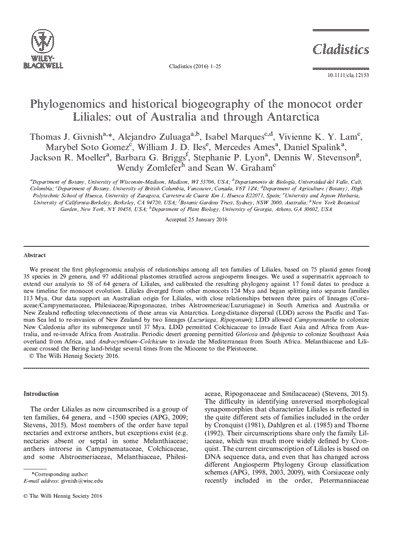NEWS 2016
Phylogenomics and historical biogeography of the monocot order Liliales: out of Australia and through Antarctica
Thomas J GIVNISH¹, Alejandro ZULUAGAA¹,², Isabel MARQUES³,⁴, Vivienne K Y LAM³, Marybel Soto GOMEZ³, William J D ILES⁵, Mercedes AMES¹, Daniel SPALINK¹, Jackson R MOELLER¹, Barbara G BRIGGS⁶, Stephanie P LYON¹, Dennis W STEVENSON⁷, Wendy ZOMLEFER8, Sean W GRAHAM³
Cladistics (2016)
doi: 10.1111/cla.12153
¹Department of Botany, University of Wisconsin-Madison, Madison, WI 53706, USA
²Departamento de Biología, Universidad del Valle, Cali,Colombia
³Department of Botany, University of British Columbia, Vancouver, Canada, V6T 1Z4
⁴Department of Agriculture (Botany), High Polytechnic School of Huesca, University of Zaragoza, Carretera de Cuarte Km 1, Huesca E22071, Spain
⁵University and Jepson Herbaria, University of California-Berkeley, Berkeley, CA 94720, USA
⁶Botanic Gardens Trust, Sydney, NSW 2000, Australia
⁷New York Botanical Garden, New York, NY 10458, USA
8Department of Plant Biology, University of Georgia, Athens, GA 30602, USA
Abstract
We present the first phylogenomic analysis of relationships among all ten families of Liliales, based on 75 plastid genes from 35 species in 29 genera, and 97 additional plastomes stratified across angiosperm lineages. We used a supermatrix approach to extend our analysis to 58 of 64 genera of Liliales, and calibrated the resulting phylogeny against 17 fossil dates to produce a new timeline for monocot evolution. Liliales diverged from other monocots 124 Mya and began splitting into separate families 113 Mya. Our data support an Australian origin for Liliales, with close relationships between three pairs of lineages (Corsiaceae/ Campynemataceae, Philesiaceae/Ripogonaceae, tribes Alstroemerieae/Luzuriageae) in South America and Australia or New Zealand reflecting teleconnections of these areas via Antarctica. Long-distance dispersal (LDD) across the Pacific and Tasman Sea led to re-invasion of New Zealand by two lineages (Luzuriaga, Ripogonum); LDD allowed Campynemanthe to colonize New Caledonia after its submergence until 37 Mya. LDD permitted Colchicaceae to invade East Asia and Africa from Australia, and re-invade Africa from Australia. Periodic desert greening permitted Gloriosa and Iphigenia to colonize Southeast Asia overland from Africa, and Androcymbium–Colchicum to invade the Mediterranean from South Africa. Melanthiaceae and Liliaceae crossed the Bering land-bridge several times from the Miocene to the Pleistocene.




